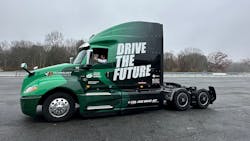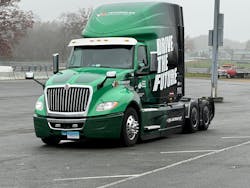Jacobs demos latest valvetrain technologies to reduce emissions
BLOOMFIELD, Connecticut—Jacobs Vehicle Systems has begun demonstrating two new technologies designed to help fleets and OEMs meet federal 2027 emissions targets.
Just outside of Hartford, Connecticut, Jacobs Vehicle Systems, widely known for the Jake Brake, showcased its third and newest demonstration truck as part of the company's 2022-23 North American Technology Tour. The tour is intended to give fleets, drivers, industry associations, and OEMs the chance to experience two of Jacobs' latest valvetrain technologies—cylinder deactivation (CDA) and active decompression technology (ADT).Jacobs began doing truck demos in 2016 to highlight its latest technology advancements for OEM customers.
"Normally, we sell to engine companies, not vehicle folks, so it was a way to kind of reach past our customers," Steve Ernest, VP of engineering and business development at Jacobs, told trade press during an event at the Thompson Motor Speedway. "We are on our third truck now, and we think this is our best truck so far."
Jacobs' latest demo truck is a custom-built International LT625 tractor with an A26 diesel engine. The vehicle is being subjected to real-world driving situations that aim to thoroughly verify the fuel-saving, emission-reducing, braking performance, and drivability of CDA and ADT.
"The key here with the demo truck is exhaust thermal management, that's everything we are going for with emissions reductions," explained Robb Janak, Jacobs' director of new technology. "We've already adopted SCR [selective catalytic reduction] aftertreatment, and we know the SCR systems need to be hot."
New regulations, Janak added, are targeting low-load operations and idle conditions, which are producing more emissions as aftertreatment systems get cold. CDA is one of Jacobs' key solutions to that thermal management, he said.
Janak added that ADT also comes into play with emissions reductions because the technology helps the start-stop of the vehicle and can promote anti-idling.
Neither technology is available for market production just yet. Jacobs is still working with OEMs and suppliers as the industry waits for 2027 engine emissions regulations to be finalized.
"There are a bunch of emissions challenges coming up," Ernest pointed out. "Some of them are still undefined, and we are waiting for wording on Euro 7 tailpipe pollution regulations. All those regulations are pushing emissions way down even further than they are today, and there are technologies out there that can help with that."
CDA: Fuel economy, emissions reductions
Jacobs' CDA is a modular valve actuation technology engineered to improve fuel efficiency by turning a six-cylinder engine into four cylinders or less, potentially improving the overall fuel economy by as much as 25% during in-lab dyno testing.
According to Jacobs, CDA reduces NOx emissions and improves fuel economy (lowers CO2) in warm-up and low engine load, such as urban driving conditions. For instance, the company noted, in a low-load cycle, a Class 8 truck equipped with Jacobs' CDA and an SCR system experienced 77% reduced NOx emissions and a 12% reduction in CO2.
With Jacobs' CDA, the cylinder deactivation mechanisms originally designed for the company's high-power density (HPD) engine brake are used in the valvetrain to disable the opening of the intake and exhaust valves.
See also: Engine braking evolves to answer needs of today’s vehicles
The hydraulically-activated mechanism is integrated in a collapsing valve bridge system for overhead camshaft engines or with a collapsing pushrod system for cam-in-block engines. When combined with disabled injection in selected cylinders, multiple cylinders can be deactivated as needed. The deactivated cylinders act as a gas spring and return the compressed energy of the air back to the crank. As a result, at low engine loads with three of six cylinders deactivated, fuel consumption can be improved by up to 20%, according to Jacobs.
Jacobs' CDA reduces emissions by achieving higher aftertreatment temperatures in the exhaust, which maintain optimal efficiency of the SCR system, even when the engine is in idle or low load operation. CDA also enables faster warm-up after engine start-up of the aftertreatment system and minimizes cooling of aftertreatment during coasting. Temperature increases of 100-200°C are achieved in low-load conditions to maintain the SCR temperature of 250°C required for optimal NOx conversion.
"With CDA activated, no cold air is being pushed through the aftertreatment system, so there is lower friction from the engine because it is not compressing the air through the engine," Justin Baltrucki, principal engineer at Jacobs, told FleetOwner. "We have less rolling resistance from the engine, and we get improved fuel consumption over a real-world drive cycle. The technology shows best when you are driving at low speed, low torque."The technology has been demonstrated and noted by the California Air Resources Board (CARB) and the U.S. Environmental Protection Agency (EPA) to meet 2024 and 2027 emission targets for low-load drive cycles in combination with an advanced SCR system. Regulators in Europe and China are widely expected to follow suit for their Euro 7 and China 7 emissions standards, Jacobs executives said during the Nov. 1 press event.
"Commercial vehicle manufacturers are looking for new and improved technologies to comply with stricter legal limits on CO2 and NOx emissions—in all parts of the world and ideally via one global engine platform," Janak said. "Cylinder deactivation is technically proven in the latest tests, such as real driving emissions and CARB low load cycle for heavy-duty trucks, to address these requirements."
CDA has been used for decades in passenger cars but is relatively new to trucking. Announced in 2018, Jacobs said its CDA hardware has so far been demonstrated on more than 20 different heavy-duty engine platforms, covering two to 15-liter engines, as well as 10 different heavy-duty truck road tests in North America, Europe, China, Japan, Korea, and India. It has undergone more than 27,000 hours and more than 200,000 miles of durability testing. There have been more than 8 billion test cycles on CDA components and over 470 million cycles of fatigue and overload testing.
Jacobs' CDA technology is also included in the U.S. Department of Energy's Super Truck 2 program, an initiative to develop and demonstrate cost-effective technologies that more than double the freight efficiency of Class 8 trucks.
ADT and driver comfort
Jacobs' ADT began as a customer-requested project to help reduce engine shake at both start-up and shutdown. Janak explained the ADT system eliminates the negative impacts of engine shutdown and restart, such as excessive cab vibration and starter wear out, while simultaneously helping to reduce energy consumption.
See also: Cummins to acquire Jacobs Vehicle Systems for $325M
ADT eliminates 90% of engine shake and can lower cranking torque by about 40%, Janak added. This has the additional benefit of preventing disturbance to drivers sleeping in cabs overnight when there are automated engine starts and stops to maintain battery charge.
ADT also has been designed to improve cold engine starts, reduce loading and wear on engine components during start-up, and makes start-up faster. In hybrid vehicles, ADT enables a faster transition from an electric motor to an internal combustion engine, Janak added.
ADT can integrate onto multiple engine platforms, according to Jacobs. Janak noted that OEM customers have been asking for ADT, but eventually, Jacobs would like to have more demand for this technology coming directly from fleet operators.
About the Author

Cristina Commendatore
Cristina Commendatore is a past FleetOwner editor-in-chief. She wrote for the publication from 2015 to 2023.


